PGRO Crop Update Number 3: 23rd June 2025
PGRO Crop Update: CB2403
Number 3: 23rd June 2025
Diseases
Powder Mildew - Peas
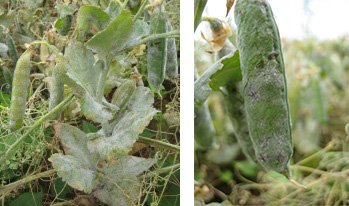
Pea powdery mildew is a damaging disease in peas that is encouraged by warm days and cooler, humid nights. The risk of infection over the next few weeks is likely to be high as the weather remains warm.
The disease forms a white, powdery film on the surface of leaves, stems and pods and can lead to yield and quality losses, including off-flavours in vining peas. Pods may develop small brown or black spots and infection may lead to uneven maturity, as infected parts of the plant senesce more slowly. Late-maturing combining peas and late-sown vining peas are particularly vulnerable. Commercial varieties show varying levels of susceptibility, with details provided in the Descriptive Lists.
Fungicides containing sulphur give effective preventative control of powdery mildew and details can be found in the PGRO Agronomy Guide: Agronomy Guide | PGRO
Bean rust
With the very warm and dry weather of recent weeks there is a high risk of damaging rust infection in bean crops. Winter beans may be past the most vulnerable stages, and if pods are full, fungicide applications may not be necessary. Spring beans, however, are still filling pods and extremely vulnerable to rust infection during the next few weeks. Fungicide applications to control rust should be made when disease is observed in the crop. Rust infection in beans is encouraged by warm days and cool, humid nights.
The disease develops as small, circular, orange pustules on the lower leaves. These become larger and develop a pale-yellow halo around the lesions. Severe infections can result in defoliation and significant yield loss.
Protectant fungicides should be applied when disease is observed. A second spray should be applied 3-4 weeks later if rust continues to develop on the upper parts of the plant. A range of products and mixtures are approved.
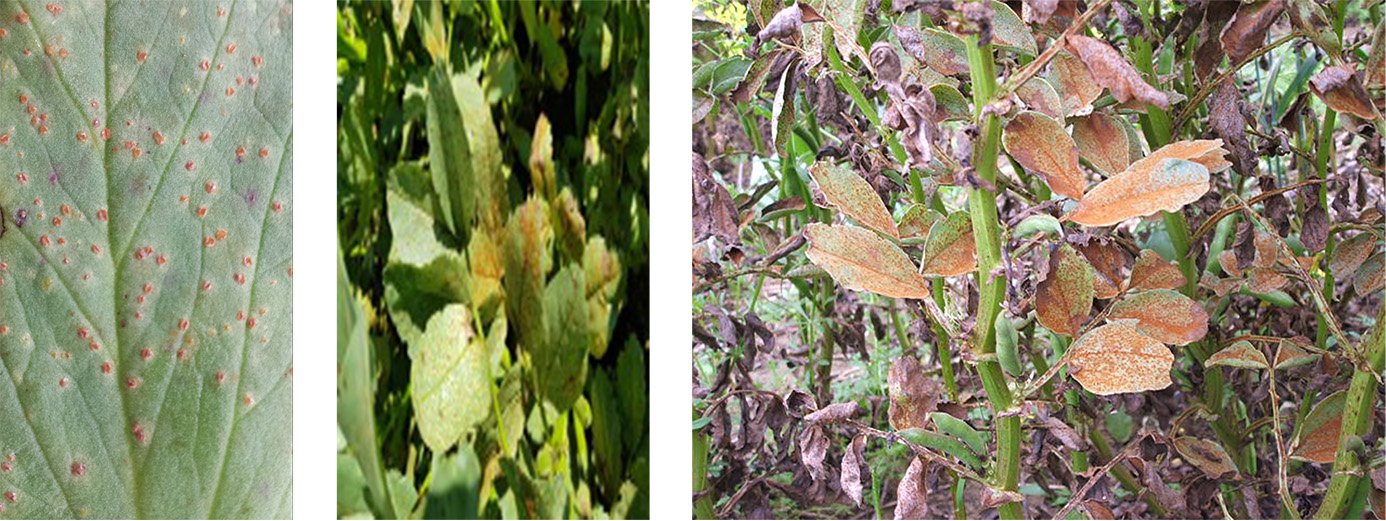
General
Foot rot (Fusarium spp., Aphanomyces euteiches, Didymella pinodella)
Some crops have been under stress during the hot, dry weather and may be showing symptoms of soil-borne foot rot diseases. Foot rot diseases in peas and beans are caused by a complex of soil borne pathogens. The most common pathogens are Fusarium spp., Didymella pinodella and Aphanomyces euteiches. These pathogens can occur individually or in combination, and yield losses can be severe.
Development of foot rot diseases is encouraged by poor soil structure, compaction, plant stress and water logging. All pathogens produce long-lasting resting spores which survive in soils for more than ten years. Frequent legume cropping leads to the build-up of pathogen levels in soils. Work has shown that some degree of yield loss can occur even where relatively low levels of pathogens are present, and the above ground symptoms of the disease may not be obvious.
Soils tests for peas are available at PGRO to test levels of the above-mentioned foot rot pathogens in soils. These levels are linked to risks of foot rot development in peas when conditions are favourable for disease development. Test results allow growers to avoid planting peas in fields which show a high risk of foot rot pathogen presence.
There are currently no chemical means to control foot rot disease in peas and beans and cultural methods to reduce compaction and waterlogging and improve soil health should be used to improve plant health and resilience to disease infection.
Pests
Pea moth
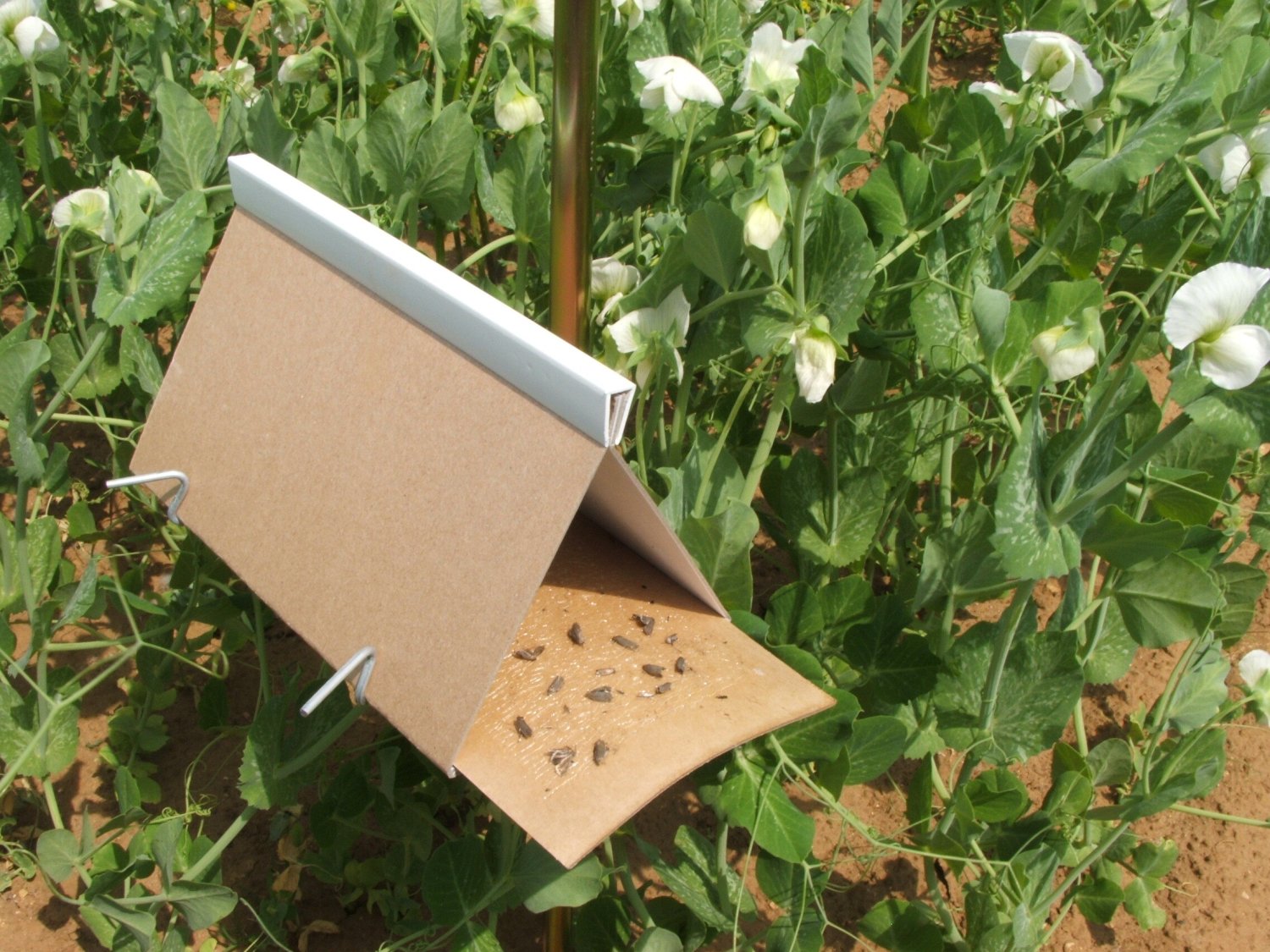
Adults have been active for some weeks in many areas and thresholds reached during the latter part of May. First insecticide applications have been made during June and follow-up applications should be made at 10-14 days after the first. Please see PGRO advice for application timing recommendations based on your trap thresholds: Pea Moth | PGRO
For products available to control pea moth please see our agronomy guide at Agronomy Guide | PGRO
Pea moth traps can be ordered from the suppliers below for next year:
One set of traps is required for a block of peas, i.e. a farm having all the pea fields within a restricted area need only purchase one set of traps, but in fields of 50 ha or more two sets are required.
Dragonfli, Unit 4 Rippers Court, Sible Hedingham, Halstead, Essex, CO9 3PY, UK
Tel: 01376 563322
www.dragonfli.co.uk
Andermatt UK, 47 Compton Road, Brighton, West Sussex, BN1 5AL, UK
Tel: 07939 395059
Email: contact@andermattuk.com
www.andermattuk.com
Koppert UK
https://www.koppert.com/challenges/caterpillars/pea-moth/
Aphids - Peas
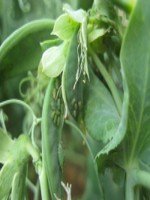
Aphids are present at high levels in many pea crops and losses due to aphids can be varied and substantial. If there is a light but general distribution in humid weather, or if breeding colonies are evident, then control measures are generally warranted. The thresholds for treatment of pea aphid to prevent direct feeding damage are as follows: spray combining peas when 20% of plants are infested and vining peas when 15% of plants are infested. Always check labels for harvest intervals.
The choice of product should be made with consideration of any other pests that are present at the time, such as pea midge and pea moth.
Timing of application can also affect the degree of virus infection as well as yield loss. In the case of pea seed-borne mosaic virus, turnip yellows virus and pea enation mosaic virus aphids should be controlled as soon as they appear, even if the above thresholds are not met and particularly if this occurs before flowering. Where aphid infestation occurs late in the growing season yield increases from aphicides can be obtained in combining peas up to the development of the fourth pod-bearing node. Where infestation occurs after this point there is no appreciable yield loss.
The new pre-flowering product available for aphid management in peas and beans, Sivanto Prime (flupyradifurone), will give effective control of pea aphids. Pirimicarb will give good control of large pea aphid colonies from first flower onwards.
Aphids – beans
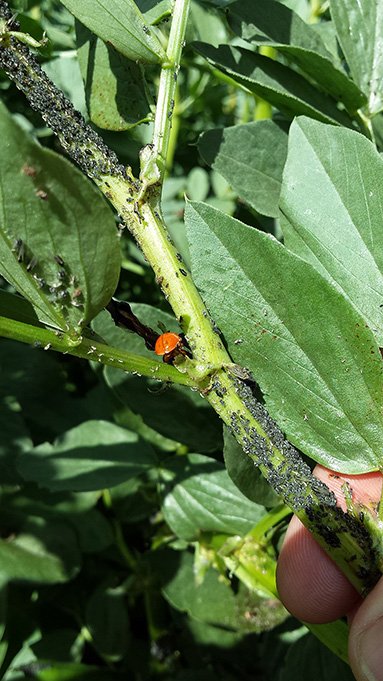
Black bean aphids are present in many crops of beans and treatment to prevent yield loss should be considered.
Spring-sown crops are usually more likely to suffer damaging attacks than winter beans. As well as forming dense, smothering colonies on the upper part of the stem, these - and the less obvious pea aphid - can transmit several viruses which add to the yield loss. Dense colonies of black aphids can develop at any time on the upper part of faba bean stems from the onset of flowering. The colonies can consist of hundreds of aphids which gradually extend downwards onto the leaves and pods. At first, individual plants may be infested, later the aphids spread into localised patches.
Damage to bean crops occurs mainly as the direct effect of aphids feeding. Plants fail to develop, and pods do not fill normally. The honeydew produced during feeding attracts secondary moulds as well as Botrytis spp. which cause chocolate spot. In addition, black bean aphids transmit viruses such as bean leaf roll virus.
Black bean aphids are relatively easy to control using aphicide sprays, but because the beans are often flowering, the choice of aphicides is limited to those which will not harm pollinating insects. Colonies first develop on headlands, but where a general infestation of 10% of plants are colonised, spraying should be carried out as soon as possible. Applications made at early flowering or when 5% of plants are infested reduce infections of aphid-transmitted viruses.
Records of aphid flights can be found on the Rothamsted Insect Survey web page: Aphid Bulletin Archive - aphids | Insect Survey.
PGRO technical information
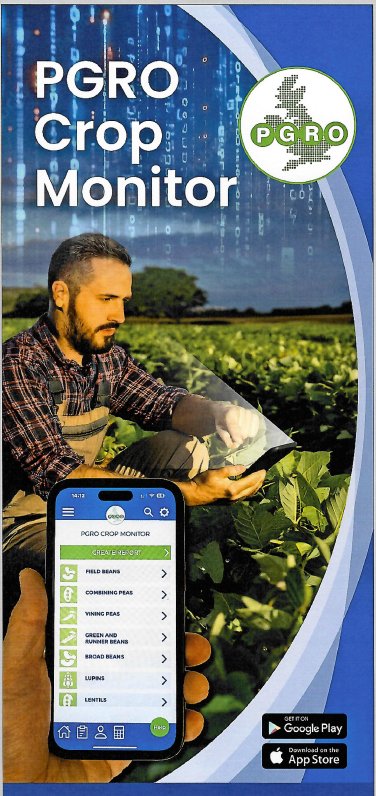
You can report issues in your crops using the PGRO Crop Monitor App, available to download and use free of charge from Google Play and i-tunes stores.
All PGRO Agronomy information has been revised to include the changes in pesticide availability for peas and beans. PGRO publications are available as free downloads from the PGRO web site www.pgro.org . User passwords are available on request through the web site.
The information in this publication must not be reproduced without the express written permission from the PGRO.
Information disseminated by the Processors & Growers Research Organisation is given after the exercise of all possible care in compilation, preparation and issue, but is provided without liability in its application or use.




